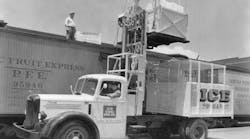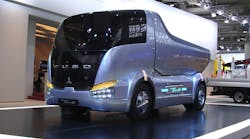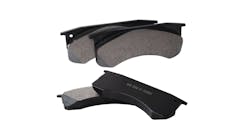When was the last time you looked at a vintage truck like a 1940s or 1950s Mack? Probably not very recently, unless you were at a museum or saw a restored fire truck proudly moving down Main Street in a Fourth of July parade. A close inspection of one of those trucks will reveal something that we no longer enjoy today: simplicity.
Those old Macks, like other trucks, had a very simple frame rail, a very basic manual transmission, cast spoke wheels and an uncomplicated electrical system that did not include even one transistor.
In many instances, the truck manufacturer even provided the body. There was no spec’ing involved when you bought a truck body, other than picking the capacity needed.
No electronics. No computers. No ABS. No automatic transmissions, and absolutely no automated mechanical transmissions.
No DPF. No SCR. No DEF. No emission control systems of any kind. Instead, you got a mechanical fuel injection system on an engine that didn’t even have a turbocharger.
Those days are long gone, as we as a society have strived to make our lives more complicated, no matter the cost. The key driver of this complexity is legislation. Safety and emissions are words we hear frequently today.
Soon, as a result of greenhouse gas emission requirements, we may see the additional burden of meeting CAFE (Corporate Average Fuel Economy) requirements in order to sell or purchase a truck. CAFE standards for commercial vehicles will be quite a challenge given the fact the chassis manufacturers don’t know in advance what body will be installed on their product. Body shape can affect fuel economy immensely.
THE NEED FOR VIGILANCE
I have seen the good, the bad and the ugly of truck spec’ing. Fortunately, I have seen mostly good spec’ing. I believe that today’s truck environment is staffed with very well-trained people.
Truck manufacturers, body and equipment manufacturers and distributors offer excellent training to sales and engineering personnel. End users have the vast potential of the Internet to guide them along and it provides an amazing amount of technological education.
But still, we must be vigilant in our desire to not make a mistake. At the end of the process, we cannot gaze upon the end result and say: “What was I thinking?”
A STARTING POINT
So, where do we start the process of insuring that the end product is good? That is an easy question. We start with an intimate familiarity of the truck manufacturer’s body builders manual and the body builder’s specifications. We then combine the two and create a great truck.
Chassis manufacturers strive to provide outstanding information about their truck products. Every specification is available to those that require this information. Dimensions, weights, component locations, frame dimensions and other specifications are all available. There is absolutely no excuse for error because of a lack of chassis information.
These body builder manuals contain drawings, schematics, diagrams, charts, graphs and pretty much everything else. Some provide comprehensive drawings for every wheelbase and model offered. Many body builder manuals are provided free of charge, and many are now available on the Internet at the manufacturer’s website.
In addition to the manuals, there are human contacts available at virtually all of the manufacturer’s facilities. You can call them, ask questions and get answers. If the application of the truck is complex, most manufacturers’ engineering staffs will provide assistance.
The chassis manufacturers don’t want any mistakes, either. The end product usually has their name on the grille and is a reflection of their company. They want the truck built right as much as the customer does.
ELECTRICAL SYSTEMS
To say that the electrical system of today’s commercial truck is complicated is an understatement. We now have computers controlling literally everything. Even simple systems like lighting are closely monitored by a computer nowadays.
Engine management computers are talking to the automatic transmission computer. These computers are looking at thousands of variables every minute the truck is running – moving or not.
It’s not unusual to see an onboard computer that has a 70-pin connector plugged into it. Just performing an action as simple as splicing into the license plate lamp wire can result in a dashboard code. Some of these systems can put the truck into a “limp in” mode of operation. Mistakes must be avoided at all cost. Avoiding a mistake can be as simple as consulting the body builder’s available information.
To be sure, trucks are going to get even more complicated in the not too distant future. Therefore, it is important to build good spec’ing and maintenance work habits now.
WEIGHT DISTRIBUTION
Let’s move on to weight distribution. I know what you’re thinking: “I am not an engineer. What do I know about calculating a vertical center of gravity? That is not my job.”
While it may not be, you must at least make sure that a detailed weight distribution analysis is done correctly – either by you or by a competent truck engineer or engineering technician.
If you need assistance doing this, reach out to the chassis manufacturer or the body builder. Here again, they do not want to see their products fail.
Gather and provide them with the necessary and correct information. The more accurate the information, the better the truck will be in the end. It will be safe, durable and reliable.
Do a weight distribution, or have one done for you. But realize that things change. So, after the initial weight distribution is complete, be prepared to do some recalculation.
I always suggest that when you are sure the final specs have been realized, get a sign off from all involved. Documentation will be to your benefit if the need arises.
ANOTHER BRAIN TEASER
Selecting a drivetrain is another puzzle in today’s truck world. There are now many alternatives to the old standby gas or diesel engine. Hybrid, CNG, LNG and even full-electric are available propulsion systems.
If the frame is the backbone of the truck, the engine is the heart. Diesel still dominates the truck world, but today we have alternatives and they are great if they serve a purpose. An alternative powertrain just for the sake of alternatives may be a mistake. The engine type must fit the specific application.
Look at the need, as well as the current equipment. Is the need being filled or is there a better way to go? Keep in mind that there is nothing worse to drive than an underpowered truck, and driver frustration sets in fast. You don’t have to buy the highest-powered vehicle on the market, but the lowest-powered vehicle may be the worst choice.
TRANSMISSIONS
Transmissions, too, are changing. Gone is the 1935 Mack 4-speed “crash box.” Today it is six, seven, eight, 10 and more gear range units.
In recent years, automated mechanical transmissions (AMTs) have been added to the mix. This type of transmission had been reserved for the high-end Aston Martin and Ferrari super performance cars. Now, you can find them in commercial trucks from many manufacturers.
AMTs pretty much operate in the same manner as a hydraulic automatic transmission, but are said to provide greater overall efficiency than the usual automatic transmission.
With all the choices, the spec’ing question is: What benefit would this transmission provide to the application? That question comes into play for each type of transmission – manual, automated mechanical, hydraulic automatic and anything else on the market.
If the final product will have a power take-off (PTO) requirement, the PTO availability may dictate the specific transmission selected.
SPEED
Final gearing and overall gearing also will be determined by the application. Where is the truck used? What does it do? How is it operated? Is it an on-road truck? Is it used off-road occasionally or frequently?
You don’t want to build a truck that will go fast on level roads but cannot engage the grade that it will encounter every day. If you are not certain how to spec final drive ratios, get help. If you know the load and grade, the factory engineering people can help you.
Speaking of speed, consider programmed speed limitation. Because operating cost control is paramount to profitability, you cannot waste anything in today’s business climate, and that includes fuel. Cutting the speed down on any vehicle, especially one that is not aerodynamic, can result in many more miles between fill ups, as well as reduced vehicle wear and tear.
Today’s engines are computer controlled and speed limiting can be done on many new products.
Don’t overlook tire spec’ing. There have been so many improvements in tire technology over the last decade that it is hard to keep up, yet you cannot afford not to. More and more low rolling resistance tires are hitting the market. Super singles are gaining popularity.
Ask your vehicle supplier what options or upgrades are available. Upgrades are called that for a reason – they offer value, and that means a return on the investment in them.
CONCLUSION
Most of the dilemmas I have seen in truck spec’ing have been dimensional problems where not enough attention was paid to the details. My dad taught me the importance of “measuring twice; cutting once.”
Too often, truck chassis show up at body companies that don’t meet the dimensional requirements of the body and/or the equipment to be installed.
A fuel tank is not in the “assumed” position. The battery box will not clear the side door. The SCR tank or the DPF interfere with an outrigger. There are problems because of an incompatible wheelbase or CA (cab to axle) dimension or an under-spec’d frame.
The result is weeping and gnashing of teeth, followed by angry phone calls. The outcomes are more expense and completion delays.
This is avoidable. Measure three times if you must, but measure. Look at the body builder manuals. Ask the manufacturer for drawings. Make certain the body supplier has this information and has signed off on it. You don’t want to be surprised at this state of the truck building process.
Truck spec’ing is important. It means a safe product, an efficient product and a reliable and durable product. Most important, it means the work gets done and customers are satisfied, and that means a good bottom line.
Robert J. Aquaro is vice president of TARA Commercial Vehicle Consulting Services (www.taracommercialvehicleconsulting.com). The company offers a full range of consulting services and seminars to the automotive and commercial vehicle sectors to include vehicle manufacturers and dealers, equipment manufacturers and distributors and fleets, as well as individual truck owners. It also provides technical and expert services to legal councils and firms.





